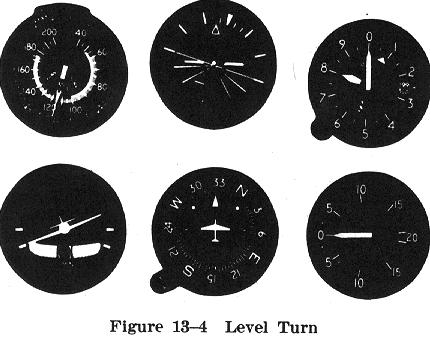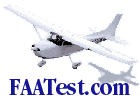| Turns to Headings
Sometimes upon encountering adverse weather conditions, it is
advisable for the pilot to use radio navigation aids, or to obtain directional
guidance from ATC facilities. This usually requires that turns be made and/or
specific headings be maintained. The rate at which a turn should be made is dictated generally by the amount of turn desired - a slow turn for small changes (less than 30 degrees) in heading, a faster turn (up to a standard rate) for larger changes (more than 30 degrees) in heading. The actual rate at which the airplane is being turned can be determined directly by the deflection of the turn indicator needle (or the turn coordinator) and indirectly by the bank angle shown on the attitude indicator (Fig. 13-4).
Before starting the turn to any new heading the pilot should
hold the airplane straight and level and determine in which direction the turn
is to be made. Then, based upon the amount of turn needed to reach the new
heading, the rate or angle of bank should be decided upon. When using the turn
indicator, the needle should be deflected either one-third or one needle width;
when using a turn coordinator the representative airplane's wings should be
banked no more than the standard marker. While making turns for large heading changes, there may be a tendency to gain or lose altitude. If the bank is controlled adequately, the altitude deviation usually will be only slight. The pilot should not be concerned about small deviations - they can be corrected after the rollout. If the bank becomes too steep, however, altitude may be lost rapidly. In this case, the bank should be shallowed rather than adding more back elevator pressure. As long as the airplane is in a coordinated bank, it continues to turn. Thus, the rollout to a desired heading must be started before the heading is reached. Therefore it is important to refer to the heading indicator to determine the progress being made toward the desired heading, and when the roll out should be started. At approximately 10 degrees before reaching the desired heading (less lead for small heading changes), coordinated aileron and rudder pressures should be applied to roll the wings level and stop the turn. This is accomplished best by reference to the attitude indicator. If only a turn indicator or turn coordinator is available, the needle should be centered or the representative wings leveled as appropriate. Failure to roll out exactly on the desired heading should cause no great alarm - final corrections can be made after the airplane is in straight and level flight and the pilot is assured of having positive control. Remember, the airplane's nose will tend to rise as the wings are being returned to the level attitude. Sufficient forward elevator pressure must be applied to maintain a constant altitude. Once again, the pilot is cautioned against "chasing" the
pointers on the instruments. The pointers should be allowed to settle down and
then adjustments made as needed.
|

